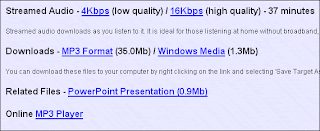The first project in the 2005/06 year was for Rob Spence’s LIT1000 class. He wanted to see if recording the lectures and making them available online was useful for the students. We made then available in WebCT as files to download or to stream online, as shown in the screenshot below.
I like that the students had a choice about how they could access the materials, but it did take me perhaps 40-50 minutes a week once I’d received the files to get them all online. This wouldn’t be scalable if more than a couple of people were recording lectures each week, so I talked with Rob about him putting the files online himself. We came across issues that prevented this. These included Rob’s PC not really being powerful enough to be converting and editing large audio files and time issues for him.
We didn’t do any organised research on the students’ use of those lectures, and because we housed them in WebCT there were no stats of their use. Robs conversations with individual students suggested to him that they were used, but not that much. He is talking about recording audio materials to support lectures in the future, rather than recording the lectures themselves.
Positives:
Easy access to resources.
Negatives:
Time consuming to prepare.
Not widely used.
Unsure of educational benefit.
To do in the future:
Explore how audio might be used to support learning in other ways than just recording lectures.
[part 2 to follow...]

3 comments:
Yes, I'd like to explore other ways of using audio. Let's talk!
Hi Peter,
I certainly agree. Producing audio/video for the web can be time consuming and cumbersome. I'm working to solve that problem now.
I am curious about a few things. Are you still involved in these projects? How has the progress been?
What was the method of recording being used? (ie. the setup/equipment?) What software was being used in either production or post-production?
One thought to improve turn-around time and limit post-production, may be to record directly to a web format as the lecture is presented while simultaneously capturing slides. Just a thought.
Also, regarding the negative: "Unsure of educational benefit" - What if the lectures were indexed, where students could click a links to jump to a specific sections of the presentation? Do think that would improve usage and overall value?
Thanks.
Carmen-
http://www.ipresent.net
Hi Carmen,
These projects with academic staff aren't currently continuing - again it's the time constraints. The methods used were recording the lecture on a voice recorder, editing it using Audacity on the PC and then using WavePad and Windows Media Encoder to convert to other formats.
All the things you say (capture in real time with slides, and indexing) are great if we're providing videos for the students. It looks like the iPresent Presio software does this, and we've experimented with using screencasting software like Camtasia Studio to create video versions of presentations.
I guess the steps forward for us include:
-Deciding if we want to do large scale lecture recording. In that case an in built automatic lecture capture system would be required in the classrooms and lecture theatres. This would need to provide both video and audio options for students to download. This would really need to be able to link in with the VLE.
-If there are just a few lecture series that need capturing we'd need a system that could capture the audio and video/screencast from the lectures. The system would need to make it really quick and easy for the academic staff to start recording at the start of the lecture, and which required little work to make available online.
Post a Comment